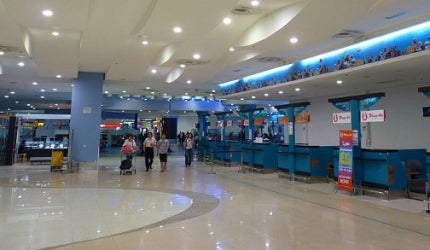
Penang International Airport, formerly known as Bayan Lepas International Airport, ranks third in Malaysia’s busiest airports, behind Kota Kinabalu International Airport and Kuala Lumpur International Airport. Located around 16km south of Georgetown, the capital of Penang, the airport links several major cities of South East Asia.
Penang International, which is owned by the Government of Malaysia, and operated by Malaysia Airports Holdings, handled more than 4.6 million passengers and 131,846t of cargo in 2011. It recorded 54,713 aircraft movements during the same year.
The airport is currently being expanded to increase its passenger handling capacity. The expansion, originally slated for completion by June 2012, has been postponed to November 2012.
Penang International terminal features
The existing passenger terminal building has two floors. Arrivals area is located in the ground floor where as the departures area is located in the first floor. A duty-free shop is located beside the departure concourse.
Expansion of Penang International Airport
Malaysia Airports, in June 2010, commenced a RM250 ($80m) expansion at the airport in anticipation of passenger traffic growing to five million by 2016. The project forms part of the Northern Corridor Economic Region (NCER) blueprint.
The expansion is being carried out in three phases. The first comprises improvement of the infrastructure, utility and buildings. The main terminal building will be upgraded under the second phase, while enhancement of airside facilities are earmarked for the final phase.
The expansion will increase the terminal’s area from 27,500m² (296,008ft²) to 52,000m² (559,723ft²). It will also increase the passenger handling capacity of the terminal from the existing 1,300 per hour to 2,000 per hour.
The new terminal will have more baggage reclaim carousels, inline baggage screening, public seating, toilets, immigration, customs and security screening counters, and aircraft parking bays. Car parking spaces will be increased to 2,000 bays from the existing 800.
The departure curb lines will be increased from the current two lines to four. The departures zone will be expanded with one extra lane, while three more lanes will be added to the arrivals zone.
The terminal’s facade will be renovated completely to give it a fresh and contemporary appeal. The terminal, once finished, will offer airlines and passengers with utmost comfort level through its facilities, state-of-the-art architecture and interior design.
Related project
Kuala Lumpur International Airport (KUL/WMKK), Malaysia
Designed to be a regional hub, Kuala Lumpur International Airport (KUL) is built with features that allow flexibility for future expansion. The development of KUL will be implemented in three phases.
Check-in systems at Penang International Airport
Penang International Airport is equipped with AirportConnect Open, the next generation IATA CUTE-compliant passenger processing system developed by SITA.
Penang International Airport runways
The airport has a single runway, which is about 10,997ft (3,352m) long. The runway is planned to be expanded in the future in order to meet the anticipated growth in passenger and freight traffic.
Penang International Airport contractors
Glidepath was contracted in September 2011 to provide a complete fail-safe inline baggage security screening system in place of the current check-in conveyor system at the airport. Glidepath subcontracted Automation Support Services for installing controls for the new baggage handling system.
Malaysian Airports awarded Smiths Detection a contract to supply and install HI-SCAN detectors and IONSCAN table-top devices at the airport, for automatic detection of explosives and narcotics.
Leading Edge Aviation Planning Professionals (LEAPP) assisted in determining the terminal space required to be expanded.






